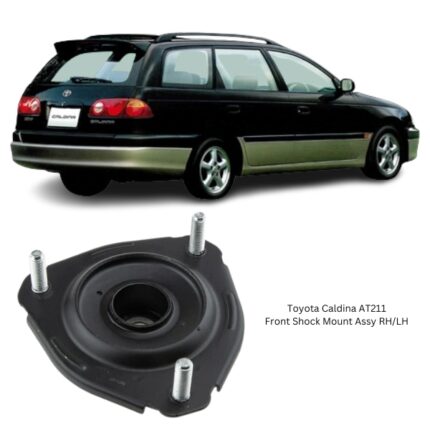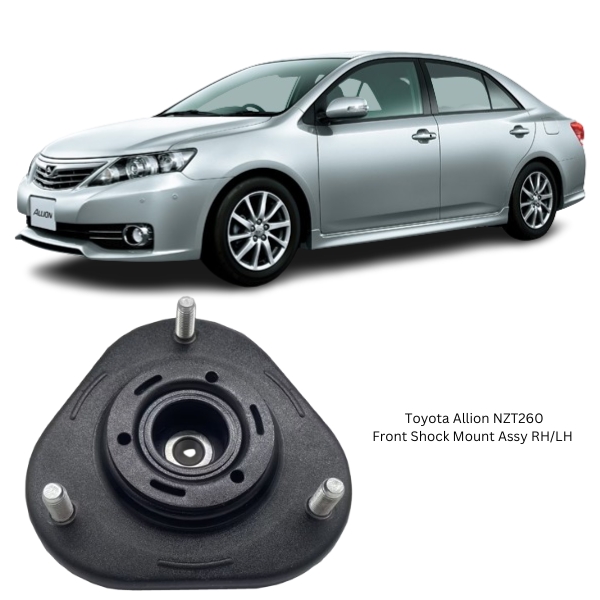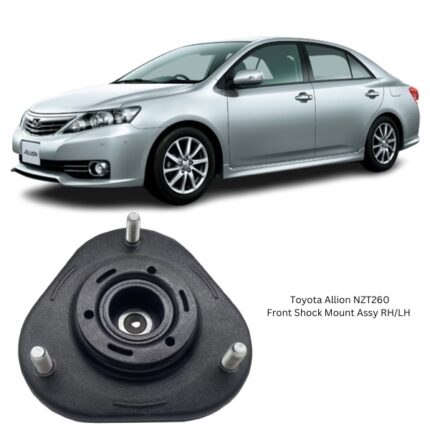Get Toyota Allion NZT260 Front Shock Mount Assy RH/LH 48609-12520 in Kenya
The Front Shock Mount Assembly RH/LH—commonly referred to as the Front Right and Left Shock Absorber Mount—is a key suspension component designed to secure the shock absorber to the vehicle chassis or strut tower while isolating vibrations and enhancing ride comfort. Installed at the top of the front shock absorber assembly, this component ensures both mechanical stability and noise dampening in the suspension system.
Despite its relatively small size, the front shock mount is essential for proper suspension function. It plays a dual role: providing a secure mounting point for the shock absorber and acting as a vibration and impact buffer between the road and the vehicle body. Whether positioned on the right-hand (RH) or left-hand (LH) side of the front suspension, the mount must endure road impacts, vehicle weight, suspension articulation, and environmental stressors without failure.
Primary Function and Role
The Front Shock Mount Assy RH/LH performs several crucial functions in the vehicle’s suspension system:
-
Shock Absorber Mounting
Serves as the upper attachment point of the shock absorber or strut, linking it to the body or strut tower. -
Vibration and Noise Isolation
Absorbs and dampens the vibrations transmitted through the shock absorber, improving ride quality and reducing noise inside the cabin. -
Suspension Load Transfer
Transmits suspension and road forces from the wheels up to the vehicle structure, while minimizing harshness. -
Steering Support (in some models)
In strut-type suspension systems, the mount may incorporate a bearing that allows the shock to rotate with the steering input, contributing to smooth and responsive handling. -
Ride Height Stability
Maintains consistent height and geometry of the suspension by keeping the shock absorber properly aligned.
Because the shock mount influences both handling and comfort, its proper condition is essential to the overall safety and drivability of the vehicle.
Design and Construction
Shock mount assemblies are engineered with a combination of metal, rubber, and in some cases, bearing components to handle dynamic forces and isolate vibration.
Core Components:
-
Metal Mounting Plate / Bracket
Typically manufactured from stamped steel or cast aluminum, this component connects the shock absorber to the chassis and is shaped to align precisely with the body’s strut tower. -
Rubber or Elastomeric Isolator
The key vibration-absorbing element. Molded rubber or polyurethane sits between the metal housing and the shock absorber rod, filtering out vibrations and small impacts. -
Inner Sleeve / Stud Bolt
A steel stud or sleeve runs through the rubber, providing a secure point for the shock absorber’s top nut or bolt. It allows the shock rod to pass through and remain fixed. -
Bearing Unit (if applicable)
In McPherson strut systems, the shock mount may incorporate a bearing race or bearing plate to facilitate smooth pivoting of the shock absorber during steering input. -
Corrosion-Resistant Finish
Shock mounts are typically coated with zinc, powder coating, or other protective finishes to resist rust, moisture, and road debris. -
Seals and Dust Covers (optional)
To protect the bearing and rubber from contamination and extend lifespan, some mounts include built-in seals or boots.
This multi-material construction ensures the mount can function in a high-load, high-vibration environment while maintaining strength and elasticity.
Performance Characteristics
The performance of the Front Shock Mount Assy RH/LH is critical to vehicle dynamics and comfort. Key performance traits include:
-
High Load Capacity
Designed to support vehicle weight, cornering forces, and vertical impacts from uneven road surfaces. -
Vibration Dampening
Effectively filters out road and suspension vibrations that would otherwise be transmitted to the passenger cabin. -
Durability and Fatigue Resistance
Engineered to endure constant compression, rebound, and rotational forces over thousands of miles without breakdown. -
Steering Smoothness (if equipped with bearing)
Ensures precise and quiet steering articulation in vehicles with strut-style suspension. -
Weather and Fluid Resistance
Maintains performance even in the presence of water, salt, oil, and temperature extremes.
Mounts that meet these criteria contribute significantly to ride comfort, suspension longevity, and vehicle handling precision.
Signs of Wear or Failure
Due to constant exposure to stress and environmental conditions, shock mounts can deteriorate over time. Common symptoms of worn or failed shock mount assemblies include:
-
Clunking or Popping Sounds
A loose or damaged mount may produce knocking noises during bumps or turns. -
Increased Road Noise and Vibration
As the rubber insulator degrades, road impacts become more pronounced inside the cabin. -
Steering Instability or Stiffness
In vehicles with integrated mount bearings, steering may become rough or resist turning if the bearing is worn. -
Uneven Tire Wear
Misalignment due to a failed mount can alter suspension geometry, leading to abnormal tire wear patterns. -
Visible Rubber Cracks or Separation
Inspection may reveal dry, cracked, or separated rubber between the mount and the metal housing. -
Excessive Suspension Travel or Leaning
A damaged mount can affect shock absorber travel, leading to poor ride quality and handling instability.
Replacing worn mounts at the earliest sign of failure helps maintain both safety and performance.
Installation Overview
Replacing the Front Shock Mount Assy RH/LH typically involves disassembling the strut or shock assembly. The process requires suspension knowledge and specialized tools:
-
Safety Measures
Raise and secure the vehicle. Disconnect any suspension components as necessary. -
Strut Removal
Remove the shock absorber or strut assembly from the vehicle, typically by unbolting from both the control arm and the strut tower. -
Spring Compression
Use a spring compressor to safely relieve tension on the coil spring before disassembling the strut. -
Remove Old Mount
Disassemble the strut top, remove the old mount, and inspect related parts (spring seat, bearing, bushing) for wear. -
Install New Mount
Align and seat the new mount correctly. Reassemble the strut, torque all bolts to specification, and reinstall into the vehicle. -
Test and Inspect
Perform a test drive to confirm noise elimination and restored suspension performance.
Professional installation is strongly recommended due to the risks associated with spring compression and suspension disassembly.
Benefits of Replacement
-
Restored Ride Comfort
Significantly reduces cabin noise and road harshness. -
Improved Steering Response
Enhances steering accuracy and smoothness (especially with bearing-integrated mounts). -
Extended Suspension Life
Prevents premature wear on shocks, springs, and control arms. -
Safety and Stability
Maintains suspension alignment and shock absorber functionality for safe driving. -
Noise Elimination
Removes unwanted rattles, clunks, and vibrations associated with worn mounts.
Follow us on Facebook for more parts.





Reviews
Clear filtersThere are no reviews yet.